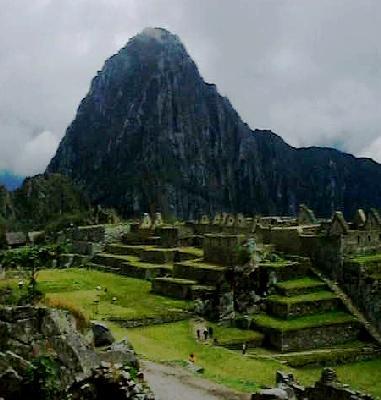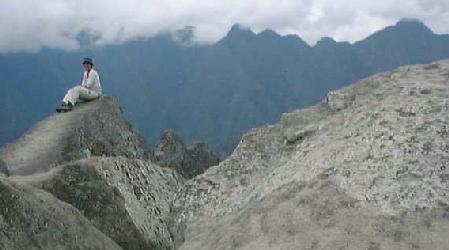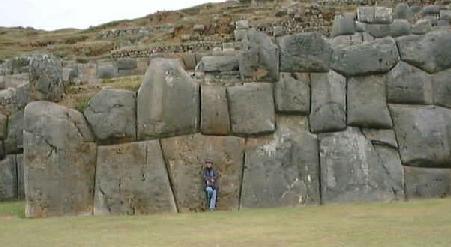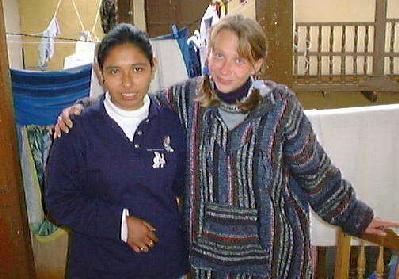
Cuzco, Machu Picchu, Peru

Veronika meets the natives, Cuzco, Peru
Thursday 21st - Friday 29th October 1999
The next morning Eoin left for Copacabana in Bolivia, and we took the bus north to Cuzco, former capital of the Inca empire and one of Peru's main tourist traps. The road was not too bad, and was paved all the way, but the journey was unpleasant - the bus broke down five minutes from Puno and proceeded to stop regularly for no apparent reason. In the end we arrived considerably late and with strained nerves from the trip. We were met at the bus station by a lady who persuaded us to check out her hotel, Hostal Tumi; it wasn't the one we'd planned to visit, as it was given only a lukewarm write-up by Lonely Planet. The sweetener was a free taxi ride if we decided to stay in the hotel. When we got there we were offered a choice of two large rooms, one with five beds, the other with three. Having been assured that we would have the rooms to ourselves and after being pleasantly surprised by the price (we'd been warned that Cuzco was expensive), we decided to stay. The rooms are centred around a pleasant courtyard and we were allowed to use the little two-ring gas stove. This was a big bonus as we were unable to find gas canisters for our camping stove, and we had some fine Costa Rican coffee (the best in the world!) we wanted to drink, particularly since Peruvian coffee is bizarre - you get a cup of hot water or milk and a small jug containing what looks like soy sauce but is in fact some form of concentrated instant coffee. Given our predilection for strong doses of caffeine in the morning, the option of using the open-air kitchen was very handy. As it turned out, the hotel was very friendly, and we were able to leave most of our luggage behind when we travelled to Aguas Calientes for the visit to Machu Picchu.
Cuzco is a beautiful city and is deservedly a UNESCO World Heritage Site. The Plaza de Armas is one of the most attractive we've seen on our travels (almost all Spanish colonial towns have one - they were the location for army drills), particularly at night when the cathedral and the university buildings are illuminated by spotlights. On the first night we again lucked out by finding a very reasonable and friendly restaurant with tasty food close to our hotel.
On our first full day in Cuzco we bought Cuzco visitors' tickets, which cover entrance to a number of museums in the city and archaeological sites in the area. We decided to get our money's worth by visiting as many of the places as possible, which we did. For me the highlights were the carved wooden pulpit of San Blas, reputedly the finest in South America and I can understand why, and the cathedral. Unfortunately, photography is banned in these sites, so you'll just have to take my word for it.
The next day (Saturday 23rd) we got up early to catch the train to Aguas Calientes for our much-anticipated visit to Machu Picchu. Two trains run each day in each direction on this route; the tourist train is about an hour quicker but doesn't stop at Aguas Calientes and costs US$55 return. Needless to say we took the cheaper option, catching the local train to AC for $4 each way.

Machu Picchu with Huayna Picchu in the background
Aguas Calientes is described in Lonely Planet as "not a bad place to hang out in" and I would have to strongly disagree. It seems to be the tourist rip-off centre of Peru (things cost double what they should do) and there is absolutely nothing to do except eat in the generally over-priced restaurants. Fortunately we found a cheap place that did excellent sopa criolla and Peruvian-Chinese fried rice at an affordable price, and we bargained successfully for our room. The railway station times its opening hours to make it impossible to visit Machu Picchu and catch the train back to Cuzco on the same day, since tickets can only be bought on the departure day, so unless you pay a local to queue for your ticket, you're forced to spend two nights in AC, two more than any sane person would want to. In addition, the ticket officer is involved in a scam with some dodgy-looking locals to corner the market in tickets for the local train for resale at inflated prices - officially tickets are limited to two per person, so a local scam merchant pays locals a small fee to queue for tickets, with the connivance of the ticket clerk. Fortunately we arrived at the ticket office early, as all the tickets were sold out soon after we had got ours.
Another aspect of the scam is that the only public transport to Machu Picchu is offered by several different bus companies, all of which charge the same fare ($7) and refuse to sell one-way tickets. The road is only 8 kilometres long, but six of those are steeply uphill on a newly constructed switchback. We reluctantly paid the price for tickets, as we wanted to conserve our energy for Machu Picchu.
Everywhere in AC and MP there are posters stating that you're not allowed to bring bottles of water or food into the site. We decided not to bring food, but did bring two litres of water. This is another side to the scam, as there is no problem taking water into the site, they just want you to buy water there at ridiculous prices ($3 for a litre and a half). Still, we managed to get student discounts to enter the site itself (reduced from $10 to $5), and Machu Picchu made up for the hassle and expense involved in getting there.
The ruins themselves are, in truth, not particularly spectacular per se, especially when compared to some of the sites we visited in Central America (e.g. Teotihuacan, Palenque, Tikal), but the setting is stunning. It sits on a mountainside (which has been terraced) and overlooks a deep valley. Towering over the ruins is Huayna Picchu (Machu Picchu means "old mountain", Huayna Picchu "young mountain") which provides the backdrop to the classic postcard shot of the site.

Veronika on Huayna Picchu
The most impressive aspect of the ruins is the stonework - huge blocks of stone were cut to fit perfectly together, with the polygonal shapes and vertical and horizontal interlocking blocks providing perfect earthquake-proofing, far more effective than the colonial buildings which followed in Peru.
We climbed Huayna Picchu, which provides superb views of the site and the surrounding mountainscape.
The return journey by train was slow and was made all the more irritating by a bizarre German couple who sat opposite us. They actually took out alcohol sterilising wipes to clean the seat (which was not actually dirty) before sitting down, and then the man flicked some dirt from his trousers in our direction while staring at us as though we were some form of untermensch. Eventually we made it back to Cuzco and I was able to restrain myself from hitting them or hurling vicious abuse, and we headed back to the Hostal Tumi where we planned to stay for another couple of nights. We reclaimed our luggage and went to bed exhausted.

Veronika and the walls of Sacsayhuaman
The next day we visited the regional history museum which had an interesting display of pre-Columbian ceramics and a less interesting (to us at any rate) collection of religious painting. Afterwards, we decided to visit Sacsayhuaman, an Inca site on a hill overlooking Cuzco. The main thing to see is the zigzag walls. The Incas envisaged the layout of Cuzco as a puma, with Sacsayhuaman as the head. The zigzag walls represent the teeth of the puma. The Spanish used many of the blocks from Sacsayhuaman for their building work in Cuzco, but what remains of the fortifications is hugely impressive simply because of the scale and the closeness of the fit of the blocks, some of which weigh 300 tonnes. Archaeological excavations are ongoing at the site, and when we were there they were digging up the temple of the sun (at least that's what I understood from overhearing a guide explaining the site to a tour group in what I think was Swedish but may have been Dutch).

Veronika and Carla, Hostal Tumi, Cuzco
We befriended Carla, a student from Puerto Maldonado (in the Peruvian jungle) who was staying in the same hotel along with her gorgeous puppy Toti. Then on Tuesday night we met a group of Italians staying in our hotel, and they invited us to join them for dinner - they were cooking spaghetti carbonara. We bought a couple of bottles of Peruvian red wine as our contribution, and we spent a very enjoyable evening eating and drinking - it was the first time we've been drunk since Guatemala. We exchanged addresses (email in our case) and we agreed to go visit them in Milan when we get back to Europe. If you're reading this Antonio, Alessio and Emanuelle, a big hello and thanks for a great evening.
Previous | Travel index | Family history | Romany | Main index